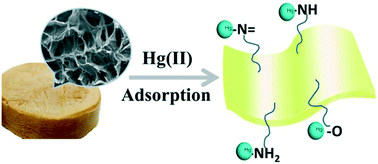Novel polyethyleneimine functionalized chitosan–lignin composite sponge with nanowall-network structures for fast and efficient removal of Hg(ii) ions from aqueous solution†
Abstract
Adsorption of heavy metals by natural polymeric composites has attracted extensive attention due to their abundance, low cost, and eco-friendliness, but these composites tend to have low adsorption capacity, long response time and poor selectivity. Therefore, it is critically desired to develop an eco-friendly adsorbent that can remove heavy metal ions efficiently and quickly from aqueous solution. Here, a novel polyethyleneimine functionalized chitosan–lignin (PEI-CS-L) composite sponge adsorbent with nanowall-network structures is synthesized by cross-linking and lyophilization. Notably, the as-prepared adsorbent could remove Hg(II) ions selectively from an aqueous solution with high efficiency at a very quick response time, reaching >83.5% of the ultimate adsorption within just 1 min. This is attributed to the evenly interconnected porous structure of the composite sponge with nanoscale-wall structures which increase the distribution of functional groups, leading to the fast complexation of heavy metal ions with surface functional groups. It is worth noting that the PEI-CS-L sponge has excellent reusability, and its adsorption capacity only decreased by 4.09% after 5 cycles of adsorption and desorption. Considering its eco-friendliness, high efficiency and low cost, the developed PEI-CS-L sponge hold great promise in removing Hg(II) ions from wastewater.

- This article is part of the themed collection: Nanomaterial applications in water


 Please wait while we load your content...
Please wait while we load your content...